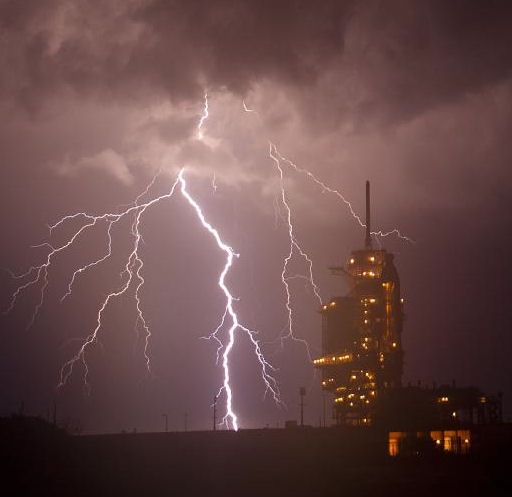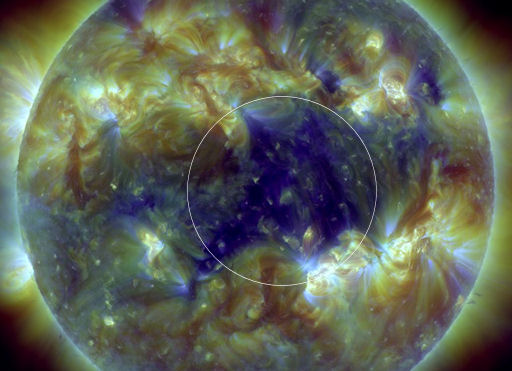Metallic photos of the sun by renowned photographer Greg Piepol bring together the best of art and science. Buy one or a whole set. They make a stellar gift. | | |
VOYAGER'S SURPRISING MESSAGE TO E.T.: NASA's Voyager probes are at the edge of the solar system carrying a message to possible extraterrestrial civilizations. Highlights include greetings from humans and whales, some of Earth's greatest music, and the brainwaves of a young woman in love. Get the full story from Science@NASA.
ENDEAVOUR LAUNCH SCRUBBED: Today's scheduled launch of space shuttle Endeavour has been scrubbed. Engineers are diagnosing a problem with one of two heater circuits associated with the shuttle's Auxiliary Power Unit. If they can solve it, NASA plans to make another launch attempt on Monday, May 2nd. Check NASA's Launch Blog for updates.
Even before the heaters failed, a launch appeared unlikely on Thursday evening when a line of thunderstorms passed the launch pad:

Good news: The weather forecast calls for clear skies on Monday. Lightning should not be a problem.
Endeavour is poised to begin a two week mission to the International Space Station. There it will deliver the Alpha Magnetic Spectrometer--a $1.5 billion cosmic ray detector that could reveal the nature of dark matter and find whole galaxies made of antimatter. The shuttle crew will also test a new automated rendevous system named, appropriately, STORMM, that will help future spacecraft dock to the ISS after the shuttle program is over.
Get ready for Endeavour's last flight: Turn your cell phone into a field-tested shuttle tracker.
CORONAL HOLE: NASA's Solar Dynamics Observatory is monitoring a hole in the sun's atmosphere--a "coronal hole." It is the dark region circled in this extreme ultraviolet image taken during the early hours of April 28th:

Above: A composite 171-193-211 Angstrom EUV image from SDO. April 28 @ 06:28 UT
Coronal holes are places where the sun's magnetic field opens up and allows the solar wind to escape. A stream of solar wind flowing from this coronal hole is expected to reach Earth on April 30th-May 1st. NOAA forecasters estimate a 35% chance of geomagnetic activity at that time.
April 2011 Aurora Gallery
[previous Aprils: 2010, 2009, 2008, 2007, 2006, 2005, 2004, 2003, 2002]
Potentially Hazardous Asteroids (
PHAs) are space rocks larger than approximately 100m that can come closer to Earth than 0.05 AU. None of the known PHAs is on a collision course with our planet, although astronomers are finding
new ones all the time.
On April 29, 2011 there were 1218 potentially hazardous asteroids.
Notes: LD means "Lunar Distance." 1 LD = 384,401 km, the distance between Earth and the Moon. 1 LD also equals 0.00256 AU. MAG is the visual magnitude of the asteroid on the date of closest approach. | | The official U.S. government space weather bureau |
| | The first place to look for information about sundogs, pillars, rainbows and related phenomena. |
| | Researchers call it a "Hubble for the sun." SDO is the most advanced solar observatory ever. |
| | 3D views of the sun from NASA's Solar and Terrestrial Relations Observatory |
| | Realtime and archival images of the Sun from SOHO. |
| | from the NOAA Space Environment Center |
| | the underlying science of space weather |
| | for out-of-this-world printing and graphics |

